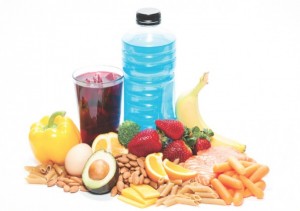How To Train Your Nutrition for an Endurance Event
 Nutrition is a key component to athletic performance. This training tip will discuss nutrition before and during your training. More specifically, training for your race day nutrition strategy. As endurance athletes, we need to possess an understanding of nutrition; what is it, how it affects us, and how it makes us feel.
Nutrition is a key component to athletic performance. This training tip will discuss nutrition before and during your training. More specifically, training for your race day nutrition strategy. As endurance athletes, we need to possess an understanding of nutrition; what is it, how it affects us, and how it makes us feel.
What is nutrition?
In general, nutrition is simply the items we intake into our digestive system. And yes, that includes plain old water. Some people confuse nutrition for substances that contain calories and while for the most part that’s true, water is a key component to our nutrition.
How does nutrition affect us?
It is important to understand how our bodies create muscle contractions in order for us to propel our bodies into movements that allow us to complete endurance events. Our bodies create muscle contracts through a series of chemical and physical reactions that are all possible because of little powerhouses called the mitochondria. If the mitochondria are not working, we cannot move. Period. Nutrition provides the necessary ingredients for these mitochondria to do their job. Quite simply: you don’t feed them, they don’t work.
How nutrition makes us feel
The primary component to “training your nutrition” is really to ascertain how our bodies react to what we ingest. It is vitally important to let your body adapt to whatever you decide to use on race day. Therefore, you need to train with your nutrition plan. If you are using gels for your race, then be sure to use them on all your long days. Do you get sick of them after 15 miles? You may want to rethink your plan.
The major item to remember about training your nutrition is if your body doesn’t “like” something you use, don’t give up on it right away, especially if you know it is a good nutritional strategy for race day. Give your body some time to adapt to what you’re ingesting. Perhaps, several weeks or so is needed for your digestive system to get to “know” it. Try adjusting the amount you take in at one time. For example, instead of taking one full gel at the top of each hour, try taking half of a gel every 30 minutes.
If you train your nutrition, you will lean what really works well for you and what doesn’t. By the time race day comes, you will be ready and your body will be adapted to your nutritional plan. Remember that your body loves water, so if you’re having digestive issues with gels (or whatever nutrition you choose) drinking a little more water than usual along with taking a gel can help make the osmolality of your nutrition similar to the osmolality of your blood allowing it to be more readily absorb out of your digestive system and where we need it, into those little powerhouses…the mitochondria.
